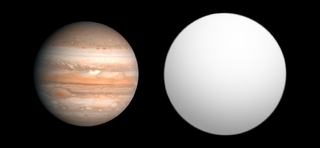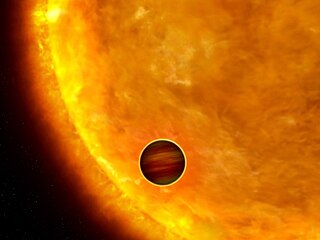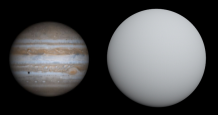Related Research Articles

CoRoT was a space telescope mission which operated from 2006 to 2013. The mission's two objectives were to search for extrasolar planets with short orbital periods, particularly those of large terrestrial size, and to perform asteroseismology by measuring solar-like oscillations in stars. The mission was led by the French Space Agency (CNES) in conjunction with the European Space Agency (ESA) and other international partners.
Pi Mensae, also known as HD 39091, is a yellow dwarf star in the constellation of Mensa. This star has a high proper motion. The apparent magnitude is 5.67, which can be visible to the naked eye in exceptionally dark, clear skies. It is nearly 60 light-years away. The star is slightly larger than the Sun in terms of mass, size, luminosity, temperature and metallicity, and is about 730 million years younger. It hosts three known planets.
WASP-8 is a binary star system of 9.9 magnitude. The star system is much younger than the Sun at 300 million to 1.2 billion years age, and is heavily enriched in heavy elements, having nearly twice the concentration of iron compared to the Sun.
81 Ceti is a star located approximately 331 light years away from the Sun in the equatorial constellation of Cetus. 81 Ceti is the Flamsteed designation for this object. It is visible to the naked eye as a dim, yellow-hued point of light with an apparent visual magnitude of 5.65. The star is drifting further away from the Earth with a heliocentric radial velocity of +9 km/s.
CoRoT-4 is a yellow-white dwarf main-sequence star in the constellation Monoceros.
Lupus-TR-3 is a star located in the southern constellation Lupus. It has an apparent magnitude of 17.4, making it visible only in power telescopes. Its distance is not well known, but it is estimated to be roughly 2,000 parsecs away from the Solar System.

CoRoT-6b is an exoplanet that was reportedly discovered by the CoRoT mission team on February 2, 2009, orbiting the F type star CoRoT-6. It is located in the Ophiuchus constellation.

CoRoT-1 is a yellow dwarf main sequence star similar to the Sun. The star is located approximately 2,630 light-years away in the constellation of Monoceros. The apparent magnitude of this star is 13.6, which means it is not visible to the naked eye; however, it can be seen through a medium-sized amateur telescope on a clear, dark night. The first exoplanet discovered in the course of the CoRoT mission orbits this star; it is considered to be a "hot Jupiter", and is approximately as massive as the planet Jupiter itself.
GSC 02620-00648 is a double star in the constellation Hercules. The brighter of the pair is a magnitude 12 star located approximately 1,660 light-years away. This star is about 1.18 times as massive as the Sun.
CoRoT-2 is a yellow dwarf main sequence star a little cooler than the Sun. This star is located approximately 700 light-years away in the constellation of Aquila. The apparent magnitude of this star is 12, which means it is not visible to the naked eye but can be seen with a medium-sized amateur telescope on a clear dark night.
CoRoT-3 is a white-yellow dwarf main sequence star hotter than the Sun. This star is located approximately 2560 light-years away in the constellation of Aquila. The apparent magnitude of this star is 13, which means it is not visible to the naked eye but can be seen with a medium-sized amateur telescope on a clear dark night.
CoRoT-7 is a binary star system. The primary, CoRoT-7A is a G-type main sequence star, slightly smaller, cooler, and younger than the Sun. It has an apparent magnitude of 11.67, fainter than Proxima Centauri, the nearest star to the Sun. This star is approximately 520 light-years away from the Solar System in the constellation Monoceros.
CoRoT-5 is a magnitude 14 star located in the Monoceros constellation.
HD 181720 is an 8th-magnitude G-type main sequence star located approximately 190 light-years away in the constellation Sagittarius. This star is larger, hotter, brighter and less massive than the Sun. Also its metal content is three-tenths as much as the Sun.
HD 215497 is a single star in the southern constellation of Tucana. It has an orange hue with an apparent visual magnitude of 8.96, which is too dim to be viewed with the naked eye. A 2015 survey ruled out the existence of any stellar companions at projected distances from 26 to 300 astronomical units. Based on parallax measurements, it is located at a distance of 132 light years from the Sun. The star is drifting further away with a radial velocity of +49 km/s, having come as close as 45 light-years some 774,000 years ago. The absolute magnitude of this star is 5.77.

CoRoT-16b is a transiting exoplanet orbiting the G or K type main sequence star CoRoT-16 2,433 light years away in the southern constellation Scutum. The planet was discovered in June 2011 by the French-led CoRoT mission.
HD 146389, is a star with a yellow-white hue in the northern constellation of Hercules. The star was given the formal name Irena by the International Astronomical Union in January 2020. It is invisible to the naked eye with an apparent visual magnitude of 9.4 The star is located at a distance of approximately 446 light years from the Sun based on parallax, but is drifting closer with a radial velocity of −9 km/s. The star is known to host one exoplanet, designated WASP-38b or formally named 'Iztok'.
CoRoT-16 is a solitary star located in the equatorial constellation Scutum. With an apparent magnitude of 16, it requires a powerful telescope to be seen, and is located 2,400 light years away based on parallax.
References
- 1 2 3 4 5 6 7 8 9 Vallenari, A.; et al. (Gaia Collaboration) (2022). "Gaia Data Release 3. Summary of the content and survey properties". Astronomy & Astrophysics . arXiv: 2208.00211 . doi: 10.1051/0004-6361/202243940 . Gaia DR3 record for this source at VizieR.
- 1 2 3 4 5 6 H. Rauer, M. Fridlund (2009). "CoRoT's exoplanet harvest" (PDF). First CoRoT International Symposium. Archived from the original (PDF) on 2011-07-20. Retrieved 2009-04-19.
- ↑ Ehrenreich, D.; Désert, J.-M. (2011). "Mass-loss rates for transiting exoplanets". Astronomy & Astrophysics. 529: A136. arXiv: 1103.0011 . Bibcode:2011A&A...529A.136E. doi:10.1051/0004-6361/201016356. S2CID 119302960.
- ↑ Chen, Di-Chang; Xie, Ji-Wei; Zhou, Ji-Lin; Dong, Subo; Liu, Chao; Wang, Hai-Feng; Xiang, Mao-Sheng; Huang, Yang; Luo, Ali; Zheng, Zheng (2021). "Planets Across Space and Time (PAST). I. Characterizing the Memberships of Galactic Components and Stellar Ages: Revisiting the Kinematic Methods and Applying to Planet Host Stars". The Astrophysical Journal. 909 (2): 115. arXiv: 2102.09424 . Bibcode:2021ApJ...909..115C. doi:10.3847/1538-4357/abd5be. S2CID 231951508.
- ↑ Damiani, C.; Lanza, A. F. (2015). "Evolution of angular-momentum-losing exoplanetary systems. Revisiting Darwin stability". Astronomy and Astrophysics. 574. arXiv: 1411.3802 . Bibcode:2015A&A...574A..39D. doi:10.1051/0004-6361/201424318. S2CID 54727372.
- 1 2 Fridlund, M.; et al. (2010). "Transiting exoplanets from the CoRoT space mission. IX. CoRoT-6b: a transiting 'hot Jupiter' planet in an 8.9d orbit around a low-metallicity star". Astronomy and Astrophysics. 512. A14. arXiv: 1001.1426v1 . Bibcode:2010A&A...512A..14F. doi:10.1051/0004-6361/200913767. S2CID 54014374.